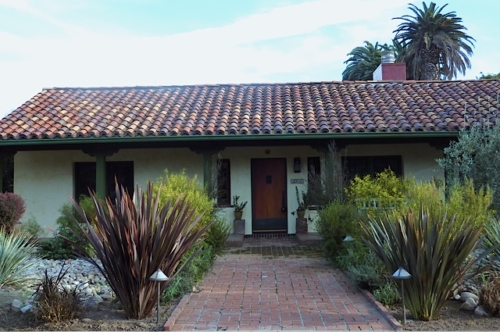John Byers Adobe

- Known As
- Spanish Colonial, California Mexican, Monterey
- Architect
- John Byers
- Built
- 1920
- Designated
- November 8, 2004
This adobe residence is the work of John Byers, an architect well known for his contributions to Santa Monica’s built environment in the 1920s and 30s. Based in Santa Monica, Byers designed many structures in the city (some twenty-eight are known today) over the course of a career that spanned more than three decades. Like many architects of the time, Byers was inspired by California’s historic architectural forms and designed in the Spanish Colonial, California Mexican, and Monterey styles. Unlike many other architects, however, Byers was a truly gifted interpreter of these styles. Indeed, experts regard Byers as among the “major architects of this style” who “left a legacy of buildings which mark a high point in American domestic architecture.”
Built in 1920, this house was one of Byers’ earliest interpretations of the architecture of California’s Mexican period (1821-1846). In many ways the structure demonstrates Byers commitment to indigenous architectural forms. First, it is built of adobe bricks. While adobe was rarely used in residential construction in the 1920s, it was the dominant building material during California’s Mexican era and, therefore, an authentic choice for this house. In addition, the structure closely mirrors the design of houses found on California’s ranchos during the early nineteenth century. Although it has since been altered, the house was originally built on a U-shaped plan around a central open patio. A full-width porch spans the front of the house, shaded by a low-pitched, red clay tile roof. The house is clad in smooth stucco. Deeply recessed windows and doors emphasize the structure’s thick adobe walls. Devoid of any applied decoration, the building is notable for its simple, rustic lines and substantial massing.
This adobe was originally built as a single-family residence and has remained so to the present day. Early residents included several middle-class families. From about 1952 until 1989 it was the home of William S. Hart, Jr., the son of silent film cowboy star William S. Hart. Over the years it has been altered several times. Most notably, a one-story garage was built on the property in 1938, a two-story addition was joined to the back of the house sometime prior to 1950, and the central patio was enclosed with a roof in 1972.
Aside from this house, several other Byers buildings have been given official landmark status in Santa Monica. John Byers office at 246 Twenty Sixth Street, his third residence at 2034 La Mesa, and the Miles Memorial Playhouse in Reed Park are among them.
Sources:
- Jean-Louis Bourgeois. Spectacular Vernacular: The Adobe Tradition. New York: Aperture Foundation, 1996. (For information on adobe construction worldwide.)
- David Gebhard and Robert Winter. Los Angeles: An Architectural Guide. Salt Lake City: Gibbs-Smith, 1994.
- Donald R. Hannaford and Revel Edwards. Spanish Colonial or Adobe Architecture of California, 1800-1850. Stamford CT: Architectural Book Publishing Co., 1990.
- Rexford Newcomb. Spanish-Colonial Architecture in the United States. New York: Dover Publications, 1990.
- Santa Monica Historical Resources Inventory, 1985-1986. City of Santa Monica, Building and Safety Department.
- Staff Report on 404 Georgina Avenue. City Planning Division, Santa Monica.